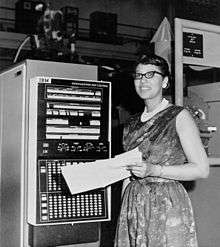African-American women in computer science
African-American women were among early pioneers in computing in the United States. Generally, they were hired as mathematicians to do technical computing needed to support aeronautical and other research. They included such women as Katherine G. Johnson and Dorothy Vaughan, who had careers of decades at NASA.[1] Among Johnson's projects was calculating the flight path for the United States' first mission into space in 1961. She is credited as co-author of 26 scientific papers. The practice in 1960 was to list only the head of the division as author. The crediting of Johnson as an author in a peer-reviewed NASA report is significant.[2]
Black women were also among the ENIAC programmers,[3] who programmed the first digital computer for the US Army. Their stories have not been documented. Given the dearth of information regarding the contributions of women in early computer science, it is likely that other Black women have made significant contributions to computer science and society.[4]

The Association for Computing Machinery (ACM) was founded in 1947, but computer science developed later as an academic field. In 1969 Clarence "Skip" Ellis became the first Black man to earn a doctorate degree in computer science.
Ten years later, the first Black woman earned a doctorate in computer science. One of the first women to earn a doctorate degree in Computer Science was Marsha R. Williams[5] at Vanderbilt University in 1982.
In the mid-1980s, the representation of women in computer science peaked at approximately 40%.[6] The decline in the representation of women has been attributed by some analysts to the increased marketing of personal computers and video games to boys.
There has been a decline in women of all races in computing in the United States; the representation of Black women in the field has continued to be lower than that of white female peers. For example, in 1985 when the number of women in computing was at a high, 77% of the related degrees were earned by White women, while fewer than 8% were earned by Black women.[7] In 2002, 1.3% of the doctorate degrees earned were awarded to Black women.
Statistics
The representation of black women in computer science has been historically low. This is well documented.[8][9][10][11][12] The Integrated Postsecondary Education Data System[7] (IPEDS) reports the following data:
| Year | Black Women (degrees) | White Women (degrees) |
|---|---|---|
| 1977 | 139 (BS), 26 (MS), 0 (PhD) | 1,275 (BS), 364 (MS), 18 (PhD) |
| 1987 | 1,536 (BS), 81 (MS), 1 (PhD) | 9,388 (BS), 1,488 (MS), 40 (PhD) |
| 1997 | 1,179 (BS), 182 (MS), 1 (PhD) | 3,599 (BS), 965 (MS), 66 (PhD) |
| 2007 | 1,624 (BS), 345 (MS), 12 (PhD) | 3,620 (BS), 1,141 (MS), 81 (PhD) |
Between 1977 and 2013 (the years in which data has been recorded by the NCES), the greatest number of Black women to earn a doctorate degree in computer science in one year was 10 (2008).
In 2012, the Computing Research Association (CRA) Taulbee Survey reported there were "merely 56 Black/African American computer science tenure-track faculty members at PhD-granting institutions, which includes 12 (or 0.6%), 21 (or 1.4%), and 23 (or 3.0%) Full, Associate, and Assistant Professors, respectively."[13]
Notable persons
The following is an incomplete list of notable Black women in computer science, in no particular order:
Representation in other media
- Margot Lee Shetterly's book, Hidden Figures: The Story of the African-American Women Who Helped Win the Space Race (2016) recounts the achievements of Katherine Johnson and other African-American women at NASA. It was adapted as a feature film, Hidden Figures, released in 2016. It stars Taraji P. Henson as Katherine G. Johnson, Octavia Spencer as Dorothy Vaughan, and Janelle Monáe as Mary Jackson, an engineer. Kevin Costner has a supporting role.
See also
- List of computer scientists
- List of African American women in STEM fields
References
- "Katherine Johnson - NasaCRgis". crgis.ndc.nasa.gov. Retrieved 2015-04-15.
- Howard, Jenny. "Meet Katherine Johnson, the computer who helped send men to the moon". Massive Science. Retrieved 2019-06-20.
- "ENIAC Programmers Project". ENIAC Programmers Project. Retrieved 2015-04-15.
- "Focus on Women of Color |". www.cdc-computing.org. Archived from the original on 2015-04-15. Retrieved 2015-04-15.
- Williams, Marsha Rhea (1982). "The design of the Computer Assisted Query Language (CAQL) System". OCLC 12957337. Cite journal requires
|journal=(help) - "The Forgotten Female Programmers Who Created Modern Tech". Retrieved 2015-04-15.
- "ncsesdata.nsf.gov – WebCASPAR|Home – US National Science Foundation (NSF)". ncsesdata.nsf.gov. Retrieved 2015-04-15.
- Hodari, Apriel; Ong, Maria; Ko, Lily T.; Kachchaf, Rachel R. (2014). "New enactments of mentoring and activism: U.S. women of color in computing education and careers". Proceedings of the Tenth Annual Conference on International Computing Education Research: 83–90. Retrieved 15 April 2015.
- Ong, Maria (July 2011). "The status of women of color in computer science". Communications of the ACM. 54 (7): 32–34. doi:10.1145/1965724.1965737.
- Frenkel, Karen A. "Women and computing". ACM Digital Library. ACM. Retrieved 15 April 2015.
- Dryburgh, Heather (2000). "Underrepresentation Of Girls And Women In Computer Science: Classification OF 1990s Research" (PDF). J. Educational Computing Research. 23 (2): 181–202. doi:10.2190/8ryv-9jwh-xqmb-qf41. Archived from the original (PDF) on 16 April 2015. Retrieved 15 April 2015.
- Taylor, Valerie. "Women of color in computing". 34 (2). ACM. ACM SIGCSE Bulletin. Retrieved 15 April 2015.
- "2011 Taulbee Survey: continued increase in undergraduate CS degree production; slight rise in doctoral production" (PDF).